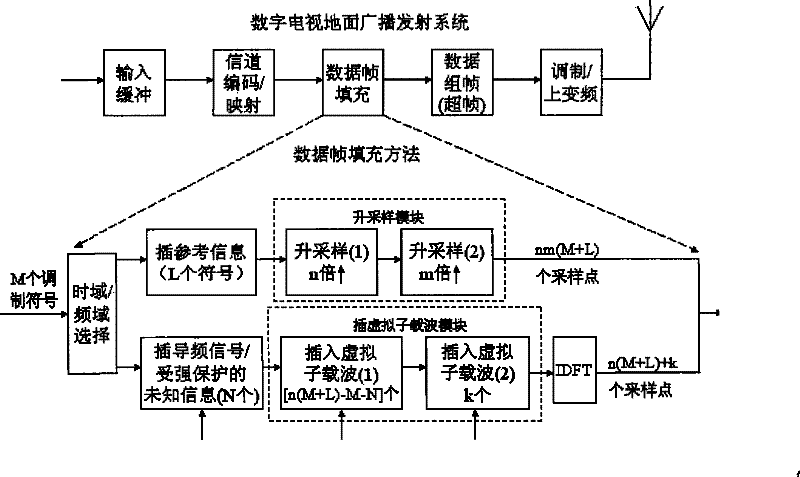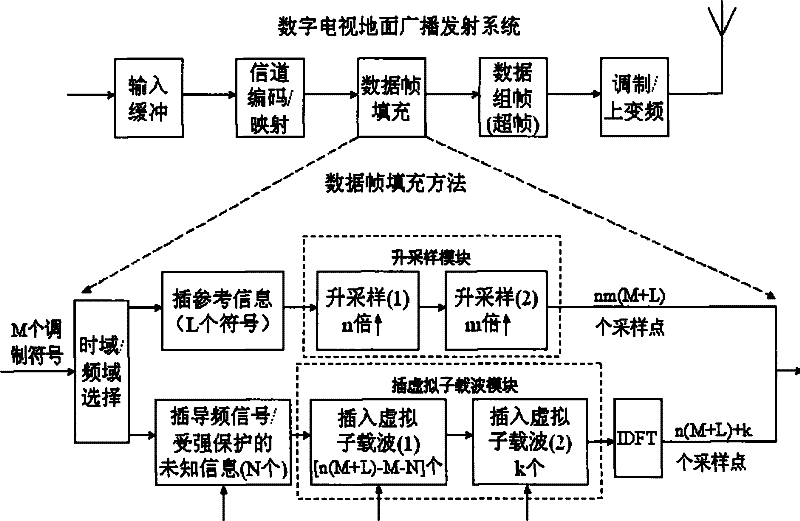Multi-modulation transmission system and data frame filling method thereof
A technology of transmission system and filling method, which is applied in the field of multi-modulation mode transmission system and its data frame filling, can solve the problems of high system implementation complexity, sensitivity to system frequency deviation, and non-support for mobile reception, etc., to reduce hardware complexity, Effective zero-frequency interference and simplified physical implementation
- Summary
- Abstract
- Description
- Claims
- Application Information
AI Technical Summary
Problems solved by technology
Method used
Image
Examples
Embodiment 2
[0064] Embodiment two assume that the frame body of each input data frame filling module includes M modulation symbols, the data symbol rate is X (symbol / second), and the data symbol rate can be 7.084MHz (symbol / second), that is, X=7.084MHz ( symbol / second), n is taken as 1, m is taken as 1, and k is taken as 0.
[0065] For the low bit rate transmission mode, the frame body of each input data frame filling module may contain 1024 modulation symbols. If time-domain processing is performed on the input data of the data frame filling module, the input data enters the system information insertion module at a symbol rate of 7.084MHz (symbol / second), and the data is output after the system information composed of 86 symbols is inserted. At this time, for the data frame filling module input of the frame body composed of 1024 symbols, the output of 1110 (that is, 1024+86) sampling points is generated. Since n=1, the sampling rate of the output is 1024 ...
Embodiment 3
[0067] Embodiment three assume that the frame body of each input data frame filling module includes M modulation symbols, the data symbol rate is X (symbol / second), and the data symbol rate can be 7.56MHz (symbol / second), that is, X=7.56MHz ( symbol / second), n is taken as 1, m is taken as 1, and k is taken as 0.
[0068] For any code rate (high code rate or low code rate) transmission mode, the frame body of each input data frame filling module can contain 3744 modulation symbols. If time-domain processing is performed on the input data of the data frame filling module, the input data enters the insertion system information module at a symbol rate of 7.56MHz (symbol / second), and the data is output after the system information composed of 36 symbols is inserted. At this time, for the data frame filling module input of the frame body composed of 3744 symbols, the output of 3780 (that is, 3744+36) sampling points is generated. Since n=1, the sampling rate of the output is ...
Embodiment 4
[0069] Embodiment 4 It is assumed that the frame body of each input data frame filling module includes M modulation symbols, and the data symbol rate is X (symbol / second). The data symbol rate may be 7.084 MHz (symbol / s), that is, X=7.084 MHz (symbol / s), n is taken as 2, m is taken as 1, and k is taken as 0.
[0070] For the low bit rate transmission mode, the frame body of each input data frame filling module may contain 1024 modulation symbols. If you choose to perform time-domain processing on the input data of the data frame filling module, the input data enters the insertion system information module at a symbol rate of 7.084MHz (symbol / s), and after inserting the system information composed of 86 symbols, the output data enters up-sampling Module, after the data is double upsampled, it will be output. At this time, for the data frame filling module input of the frame body composed of 1024 symbols, the output of 2220 (that is, 2×(1024+86)) sampling points is generated. S...
PUM
 Login to View More
Login to View More Abstract
Description
Claims
Application Information
 Login to View More
Login to View More - R&D
- Intellectual Property
- Life Sciences
- Materials
- Tech Scout
- Unparalleled Data Quality
- Higher Quality Content
- 60% Fewer Hallucinations
Browse by: Latest US Patents, China's latest patents, Technical Efficacy Thesaurus, Application Domain, Technology Topic, Popular Technical Reports.
© 2025 PatSnap. All rights reserved.Legal|Privacy policy|Modern Slavery Act Transparency Statement|Sitemap|About US| Contact US: help@patsnap.com



